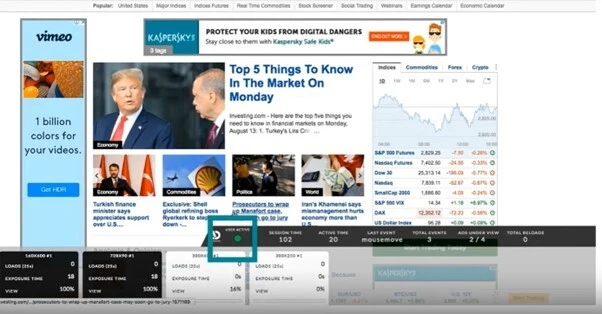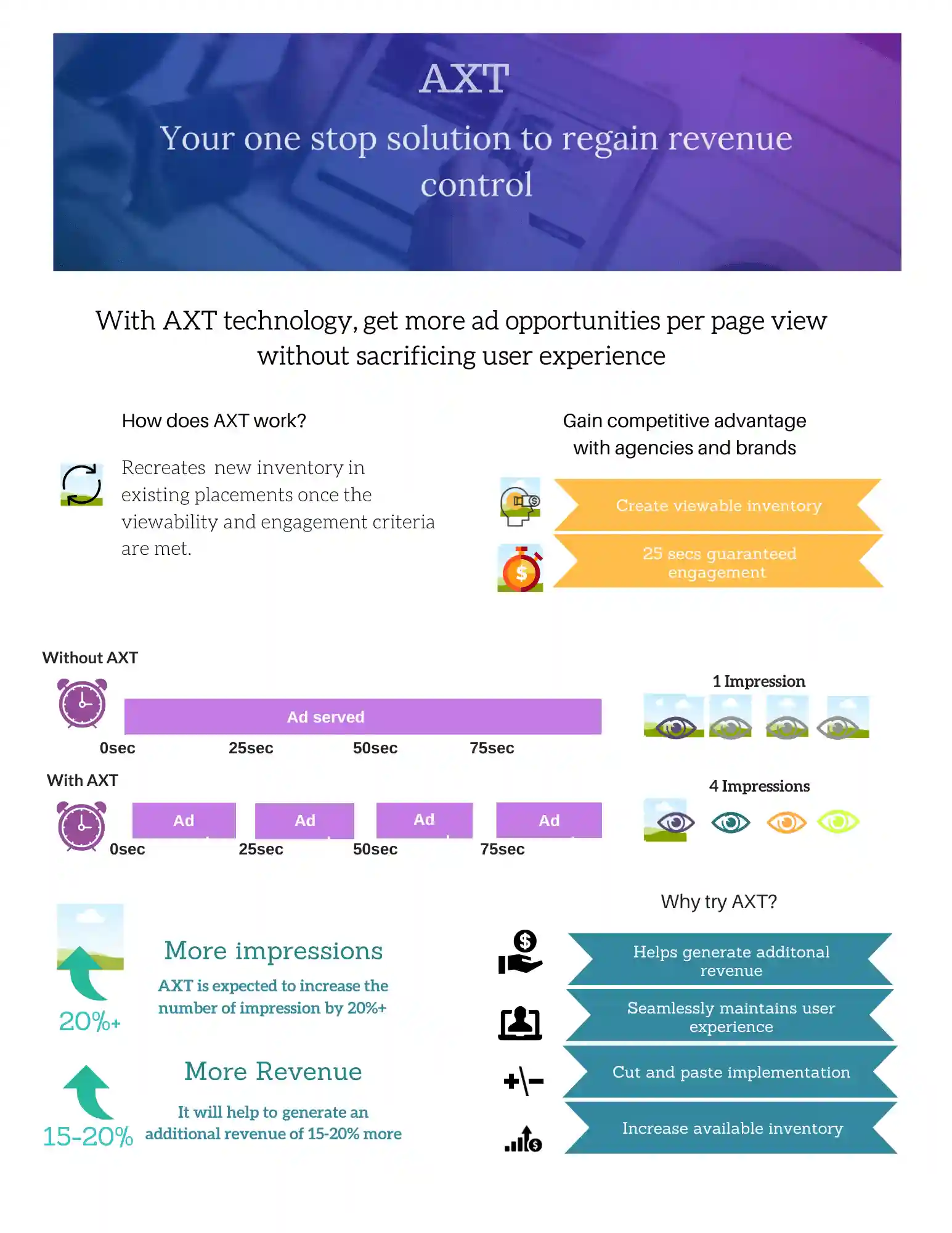“Ad Refresh means incremental ad revenue.”
– Your XYZ Monetization Partner
Well, I will take it, but with a pinch of salt. Ad refresh certainly generates extra revenue by increasing the number of ad impressions served to visitors in a single session. But if not done correctly, you might end up losing both – your precious visitors and your valued demand partners.
I prefer calling it traditional ad refresh (full of ifs and buts), and my solution to this is “In-View Ad Refresh”.
In-view ad refresh solution ensures that your ad slots replace the existing ad creative with the new one only when the user is really paying attention. Simply put, the ad refreshes only when the ad space is in view.
Let’s explore the concept in detail, and as a bonus tip, I have explained the perfect tool you will need to enjoy the full potential of the ad refresh. But first, let’s start with the basics.
Table of Contents
What Is Ad Refresh?
Ad Refresh refers to the process of serving new ads on the ad spaces to the same impression (user) during the same session based on predefined triggers. Let’s understand this with an example.
Suppose the predefined refresh trigger is set to be a time trigger of 15 seconds. A user visits your website’s page, and there are four inventories on it. Ads get displayed as the page loads. Now, after the timer hits 15 seconds, all the existing ads will get replaced by new ads.
This strategic rotation prevents users from getting bored by seeing the same ads repeatedly. At the same time, you can generate extra revenue from the same impression.
The goal is simple yet impactful – to keep your revenue-generating inventories attractive and effective.
How Does Ad Refresh Work?
Ad refresh is usually powered by embedded JavaScript code on your website. This code keeps an eye on user activity and triggers ad refresh under specific conditions:
- Time-based triggers: Ads refresh after a set duration, like every 25 seconds.
- User action triggers: Refresh happens when users scroll, click, or perform specific actions.
- Custom event triggers: Ads refresh based on events like video completion.
Once triggered, the JavaScript fetches a new ad from the server and showcases it in the designated ad unit.
If you want to increase your revenue via ad refresh, then we recommend reading our article: 5 Rules for Ad Refresh to Double Your Ad Revenue.
The challenge: Confirming real user engagement
But there’s a snag. Open but inactive browser tabs can sometimes unintentionally trigger automatic ad refreshes, leading to refreshed ads without actual views. Here are potential drawbacks to watch out for:
- Diminished value: Frequent refreshes can reduce perceived value for advertisers, impacting their ROI.
- Reduced viewability: Refreshing ads when users aren’t looking at the page can drop ad viewability.
- Increased ad fraud: Ad refreshes might inflate ad impressions, potentially leading to more ad fraud.
All these challenges can hit your revenue. Advertisers may be less keen to pay for ad impressions through refreshes, reducing your demand and earnings.
Make Way for In-View Ad Refresh
In-view ad refresh is a technique used by publishers to optimize the display of ads by refreshing them only when they are in the user’s viewable area on a webpage.
This approach ensures that ads are refreshed strategically when they are likely to be seen by the user, thus maximizing the opportunity for engagement.
Why is in-view ad fresh better than the traditional ad refresh method?
Traditional ad refresh refreshes ads even when the ad slot is not in the visible to the visitor.
In-view ad refresh aims to enhance the effectiveness of advertising by tying refreshes to the actual visibility of the ad to the user.
This can lead to a more efficient use of ad impressions and improved performance for advertisers.
Introducing Active Exposure Time (AXT)
Active Exposure Time (AXT) is a tool that helps publishers optimize their ad revenue and user experience by refreshing ads only when they are 75% or more visible to the user and the user is engaged with the page.
AXT measures the time the user spends on the page while an ad is in view. Once the AXT hits 15 seconds, a new ad will be served in the same unit without any delay. Then, the second impression is counted, and the AXT timer will be started again.
This way, AXT ensures that the ads are refreshed only when they have the highest visibility and relevance.
How can you use AXT as a publisher?
- To start using AXT as a publisher, contact Automatad’s Ad Ops team. We will apply the AXT tool to assist you in measuring and enhancing your ad revenue.
Bonus – although it’s a complimentary service to our publishers using Automatad as their monetization partner, we also provide AXT as plug and play. You just need to add our exclusive JavaScript, and we will do the rest.
2. The AXT tool will examine metrics including:
- User active – This evaluates whether a user engages with a web page. The toggle remains green if a user is active and turns grey if the user is inactive for more than 5 seconds.
- Session time – This metric runs from the time the webpage is loading.
- Active time – It is the total time a user spends actively engaged with a web page. This is similar to the user active metric but counts the total time the user actively interacts with the page. If the user is inactive for more than 5 seconds, then the timer stops and resumes once the user is active again.
- Last event – It measures the time of the last event that a user triggered on a webpage. This event could be anything like clicking on a link, scrolling the page, or using the mouse.
- Total events – This metric measures the total number of events that a user triggers on a webpage.
- Ads under view – This is the number of ads currently in view on a webpage to the user at a given time.

3. Our team will use the above metrics and more to implement in-view ad refresh effectively.
So that you can check when your users are active.

Hit the 15-25 second threshold. And the ads are refreshed when they are 75% in-view. It’s that simple.
What AXT can do for you?
Here’s a quick rundown of how AXT can transform your ad game:
- Increased ad viewability: AXT ensures that ads are only served to users actively engaged with the webpage. This means that ads are more likely to be seen and clicked on with little to no impact on the UX of the website. This can attract higher bids from advertisers and increase the increase the CPM and RPM of the inventory.
- Increase ad impression: It increases the number of ad impressions served per user session. This can boost the revenue per session and upsurge the overall ad revenue.
- Increase ad demand/competition: AXT can attract higher bids from advertisers who value metrics such as viewability and relevancy. Also, you can add a header bidding option for this newly created ad inventory, resulting in increased RPM for the web page.
- Improved ad effectiveness: AXT also increases the session time as users can interact with more ads, resulting in improved ad performance and increased ROI.
- Improve user experience: By ensuring that new ads are served to users actively engaged with the webpage, AXT can help reduce ad fatigue. This can lead to a more positive user experience and increased ad acceptance. Also, it reduces the number of ad placements on the webpage while not compromising the revenue streams.

Ready to Try It Out?
Are you ready to see how AXT can transform your ad inventory and maximize revenue?
Contact Automatad today to schedule a demo and experience the power of AXT firsthand. Our experts will guide you through the process and help you implement AXT seamlessly into your website.
With AXT, you can unlock a new level of ad performance and achieve your business goals. Take advantage of this opportunity to level up your ad monetization strategy.
With Active Exposure Time (AXT), make every ad view count. Contact Automatad now!






















